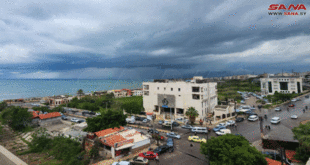Provinces, SANA-The positive indexes of the agricultural situation in Syria refute the falsifications and the fabrications broadcasted by misleading media channels that there is a bread crisis in Syria.
According to official sources, Syrians expect this year an exceptional agricultural season, thanks to the efforts exerted by the peasants and the government for making a success to the marketing season.
The rain falls at the agricultural stable areas have witnessed, improvement of security circumstances in a number of rural areas, decrease of the production costs and the paucity of insects’ casualties are the main factors of improving wheat production rates. The aforementioned factors will also positively affect wheat stockpile reality and food security in Syria in general.
Director of Agriculture and Agrarian Reform in Hasaka province, Amer Selo told SANA the suitable weather circumstances this year have played role in developing the growth of wheat during the last two months.
For his part, Head of Botanical Production Department at Agriculture and Agrarian Directorate, Azzawi al-Azzawi, asserted that the areas planted with irrigated wheat in Hasaka amounted to 157, 600 hectares while the rain-fed wheat areas amounted to 298,125 hectares, expecting production of the irrigated and rain-fed wheat crops in the province to reached more than 755 thousand tons.
Preparations for starting the harvest season are going by leaps and bounds, said Director General of the Cereal Manufacturing Establishment, Moosa Nawwaf al-Ali, underlining the government’s keenness to buy the whole production of wheat to encourage the farmers on cultivating their lands and enhancing the strategic stockpiles through setting a price compatible with their efforts and the production costs.
In Homs province, wheat cultivation has witnessed a remarkable improvement comparing with the last year as a result of the heavily rain falls.
Head of Homs Agriculture Directorate Nazih al-Rifaie expected that wheat quantities of the current season to reach about 53,548 tons, comparing with 18, 622 tons last year.
Head of Statistics Department at Agriculture Directorate, Ihsan al-Tahish, stated that restoring stability and security to a number of villages in Homs countryside has encouraged the farmers to cultivate their lands. So, the wheat planted lands during the current season reached to 28,098 hectares, including 12,390 hectares irrigated and 15,708 hectares are rain-fed.
Director of the Agriculture and Agrarian Reform in the southern Daraa Province , Abdulfattah al-Rahhal stated that the area scheduled for planting irrigated wheat in the province for this season amounted to 12, 842 hectares, about 10,009 hectares were planted, while the area scheduled for cultivating the rain-fed wheat amounted to 64,513 hectares, of which 47,007 hectares were planted.
In Sweida province, the implementation of the wheat season’s agricultural plan for this year exceeds 90% where the wheat-planted-area totaled 28, 908 hectares, only 240 hectares of it are irrigated.
Director of Seeds Increasing Branch in Sweida,Wael al-Taweel clarified that quantities of the distributed wheat seeds during the season totaled at 1,614 tons, with a 210 tons increase comparing with the last season, attributing this increase to the improvement of rain falls and the farmers’ trust in the seeds’ quality.
In Hama, the lands planted with wheat, under the supervision of the General Commission for Managing and Developing al-Ghab, amounted to 52,392 hectares, of which 48,787 hectares irrigated while 3, 605 hectares are rain-fed.
Head of the Crops Section in Hama Agriculture Directorate Marwa Ekrem stated that 76% of the agricultural plan is implemented and the wheat crops within Hama agricultural lands, which are estimated at 25,295 hectares, are good.
In the light of the previous data, Syrians assert once again their determination and steadfastness to challenge the siege and pressure imposed on them in order to ensure food security and their daily needs.
Reem Abdul-Kareem/Barry
 Syrian Arab News Agency S A N A
Syrian Arab News Agency S A N A


